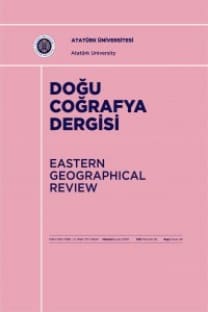AVRUPALI TÜRKLER: MİSAFİR İŞÇİLİKTEN AVRUPA VATANDAŞLIĞINA
Bu çalışmada Türk vatandaşlarının çeşitli Avrupa ülkelerine olan göçleri tarihsel ve coğrafi karakteristikleri ile ele alınmakta ve Türk göçmenlerin entegrasyon süreçleri analiz edilmektedir. Çalışmanın birinci kısmında Türklerin Avupa ülkelerine göçünün tarihsel süreci, göçmenlerin sosyal, ekonomik ve kültürel arkaplanları ile göçün coğrafi karakteristikleri incelenmektedir. İkinci kısımda ise Türk göçmenlerin entegrasyon süreçleri ve durumları hem teorik hem de ampirik bakımdan incelenmektedir. Çalışma ampirik verilerden yararlanarak ve etnik coğrafya teorik temeline dayanarak Türk göçmenlerin eğitim durumları, ekonomik statüleri, sosyal ve siyasal katılımları, farklı Avrupa ülkeleri arasındaki farklılıkları ve benzerlikleri ortaya koymaktadır.
Anahtar Kelimeler:
Avrupalı Türkler, Göç, Misafir işçi
___
- Alba, R. D. 2005. Bright vs. blurred boundaries: second generation assimilation and exclusion in France, Germany and the United States. The Ethnic and Racial Studies 28 (1):20-49.
- Anil, M. 2007. Explaining the Naturalisation Practices of Turks in Germany in the Wake of the Citizenship Reform of 1999. Journal of Ethnic and Migration Studies 33 (8):1363 - 1376.
- Argun, B. E. 2003. Turkey in Germany: The Transnational Sphere of Deutschkei. New York: Routledge.
- Avcı, G. 2005. Religion, Transnationalism and Turks in Europe. Turkish Studies 6 (2):201 - 213.
- ———. 2006. Comparing Integration Policies and Outcomes: Turks in the Netherlands and Germany. Turkish Studies 7 (1):67 - 84.
- Coenders, M., and P. Scheepers. 2008. Changes in Resistance to the Social Integration of Foreigners in Germany 1980-2000: Individual and Contextual Determinants. Journal of Ethnic and Migration Studies 34 (1):1 - 26.
- Cornell, S. E., and D. Hartmann. 1998. Ethnicity and Race: Making Identities in a Changing World, Sociology for a New Century. Thousand Oaks, Calif.: Pine Forge Press.
- Crul, M. 2007. Pathways to Success for the Second Generation in Europe. Migration Information Center 2007 [cited November 23 2007]. Available from http://www.migrationinformation.org/Feature/display.cfm?ID=592.
- Jackson, P., and J. Penrose. 1994. Constructions of Race, Place, and Nation. Minneapolis: University of Minnesota Press.
- Kaya, A. 2005a. Citizenship and the hyphenated Germans: German-Turks. In Citizenship and Identity in a Globalizing World: European Questions and Turkish Experiences, eds. F. Keyman and A. İçduygu. London: Routledge.
- ———. 2005b. Recoding Europeanness: A comparative study of German-Turks and French- Turks. HAGAR Studies in Culture, Polity and Identities 6 (1):87-117.
- Kaya, I. 2004. Turkish American Immigration History and Identity Formations. the Journal of Muslim Minority Affairs 24 (2):295-208.
- ———. 2005c. Identity and Space: The Case of Turkish Americans. Geographical Review 95 (3):425-440.
- Kirisci, K. 2007. Turkey: A Transformation from Emigration to Immigration. Migration Information Center 2003 [cited November 23 2007]. Available from http://www.migrationinformation.org/Profiles/display.cfm?ID=176.
- Lucassen, J., and L. Lucassen. 1997. Migration, migration history, history: old paradigms and new perspectives, International and comparative social history, 4. Bern; New York: Peter Lang.
- Lucassen, L. 2005. The immigrant threat: the integration of old and new migrants in western Europe since 1850, Studies of world migrations. Urbana: University of Illinois Press.
- Lucassen, L., D. Feldman, and J. Oltmer. 2006. Paths of integration: migrants in Western Europe (1880-2004), IMISCOE research. Amsterdam: Amsterdam University Press.
- Manco, U. 2007. Turks in Europe: From A Garbled Image to The Complexity of Migrant Social Reality http://www.flwi.ugent.be/cie/umanco/umanco5.htm. [cited 23 November 2007]. Available from
- Oezcan, V. 2007. Fewer Ethnic Germans Immigrating to Ancestral Homeland. Migration Information Center 2004 [cited November 23 2007]. Available from http://www.migrationinformation.org/Feature/display.cfm?id=201.
- Pécoud, A. 2003. Self-Employment and Immigrants' Incorporation: The Case of Turks in Germany. Immigrants & Minorities 22 (2):247 - 261.
- Razum, O., N. Sahin-Hodoglugil, and K. Polit. 2005. Health, Wealth or Family Ties? Why Turkish Work Migrants Return from Germany. Journal of Ethnic and Migration Studies 31 (4):719 - 739.
- Söhn, J., and V. Özcan. 2006. The Educational Attainment of Turkish Migrants in Germany. Turkish Studies 7 (1):101-124.
- Strüder, I. 2003. Self-employed Turkish-speaking women in London: Opportunities and constraints within and beyond the ethnic economy. The International Journal of Entrepreneurship and Innovation 4 (2):185-195.
- Timmerman, C. 2006. Gender Dynamics in the Context of Turkish Marriage Migration: The Case of Belgium. Turkish Studies 7 (1):125 - 143.
- Van Londen, M., K. Phalet, and L. Hagendoorn. 2007. Civic Engagement and Voter Participation among Turkish and Moroccan Minorities in Rotterdam. Journal of Ethnic and Migration Studies 33 (8):1201 - 1226.
- Van Tubergen, F. 2007. Religious Affiliation and Participation among Immigrants in a Secular Society: A Study of Immigrants in The Netherlands. Journal of Ethnic and Migration Studies 33 (5):747 - 765.
- Yazarsız. 2003. Gurbetçilerin üçte biri AB’li. Zaman, 08 Aralık.
- Yurdakul, G. 2006. State, Political Parties and Immigrant Elites: Turkish Immigrant Associations in Berlin. Journal of Ethnic and Migration Studies 32 (3):435 - 453.
- ISSN: 1302-7956
- Yayın Aralığı: Yılda 2 Sayı
- Başlangıç: 1995
- Yayıncı: Prof.Dr. İbrahim Fevzi ŞAHİN
Sayıdaki Diğer Makaleler
OSMANİYE’DE KENTSEL ARAZİ KULLANIMINDAN KAYNAKLANAN MEKÂNSAL SORUNLAR
ULAŞIM COĞRAFYASI AÇISINDAN ÖNEMLİ BİR GÜZERGÂH: KARABÜK-BARTIN KARAYOLU
ANDIRIN İLÇESİ’NDE SAYFİYE YAYLALARI
HASAN DAĞI’NDA (AKSARAY-NİĞDE) HÂLÂ ÖNEMİNİ KORUYAN BASİT SU YAPILARI: SARNIÇLAR VE KUYULAR
POLAT MAĞARASI ve TURİZM POTANSİYELİ
TÜRKÇE, SOSYAL BİLGİLER VE SINIF ÖĞRETMENLİĞİ ÖĞRENCİLERİNİN COĞRAFYA DERSLERİNE OLAN İLGİ DÜZEYİ
KARLIOVA’NIN ARICILIK POTANSİYELİ VE DEĞERLENDİRME DURUMU
TÜRKİYE-İRAN SINIRI: SINIRIN COĞRAFİ DURUMU VE SINIR KÖYLERİMİZİN SOSYO-EKONOMİK YAPILARI
AVRUPALI TÜRKLER: MİSAFİR İŞÇİLİKTEN AVRUPA VATANDAŞLIĞINA
DİLEK YARIMADASI-BÜYÜK MENDERES DELTASI MİLLİ PARKI VE YÖRE EKONOMİK FAALİYETLERİ İLİŞKİSİ
